NCERT Solutions for Class 10 Maths Chapter 11 Constructions Ex 11.1 are part of NCERT Solutions for Class 10 Maths. Here are we have given Chapter 11 Constructions Class 10 NCERT Solutions Ex 11.1.
In this NCERT For Class 10 Maths Chapter 11 Constructions students will learn the following topics given below. Here Students can find all NCERT Questions for class 10 Constructions, Additional Questions of Constructions and Solved Previous Year Questions. Our free NCERT Textbook Solutions for Chapter 11 – Constructions will strengthen your fundamentals in this chapter and can help you to score more marks in the examination. Refer to our Textbook Solutions any time, while doing your homework or while preparing for the exam.
| Board | CBSE |
| Textbook | NCERT |
| Class | Class 10 |
| Subject | Maths |
| Chapter | Chapter 11 |
| Chapter Name | Constructions |
| Exercise | Ex 11.1 |
| Number of Questions Solved | 7 |
| Category | NCERT Solutions |
NCERT Solutions for Class 10 Maths Chapter 11 Constructions Ex 11.1
Page No: 219
Question 1.
Draw a line segment of length 7.6 cm and divide it in the ratio 5:8. Measure the two parts.
Solution:
The steps of construction are as follows:
1. Draw line segment AB of 7.6 cm and draw a ray AX making an acute angle with side AB.
2. Locate 13 (= 5 + 8) points A1, A2, A3, A4….. A13 on AX such that AA1 = A1A2 = A2A3 … = A12A13
3. Join BA13.
4. Through the point A5 draw a line parallel to BA13 (by making an angle equal to ∠AA13B) at A5 intersecting AB at point C.
Now C is the point dividing line segment AB of 7.6 cm in the required ratio of 5: 8.
We can measure the lengths of AC and CB. The length of AC and CB comes to 2.9 cm and 4.7 cm respectively.
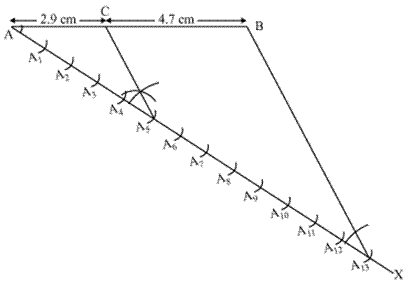
Question 2. Construct a triangle of sides 4 cm, 5 cm and 6 cm and then a triangle similar to it whose sides are 2/3 of the corresponding sides of the first triangle.
Solution:
The steps of construction are as follows:
1. Draw a line segment AB = 4cm. Taking point A as centre draw an arc of 5 cm. radius. Similarly, taking point B as its centre, draw an arc of 6 cm radius. These arcs will intersect each other point C. Now AC = 5 cm. and BC = 6 cm and ∆ABC is the required triangle.
2. Draw a ray AX making acute angle with line AB on opposite side of vertex C.
3. Locate 3 points A1, A2, A3 (as 3 is greater between 2 and 3) on line AX such that AA1= A1A2 = A2A3.
4. Join BA3 and draw a line through A2 parallel to BA3 to intersect AB at point B’.
5. Draw a line through B’ parallel to the line BC to intersect AC at C’. ∆AB’C’ is the required triangle.

Question 3. Construct a triangle with sides 5 cm, 6 cm and 7 cm and then another triangle whose sides are 7/5 of the corresponding sides of the first triangle.
Solution:
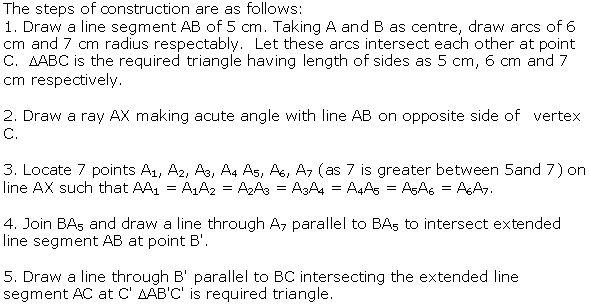
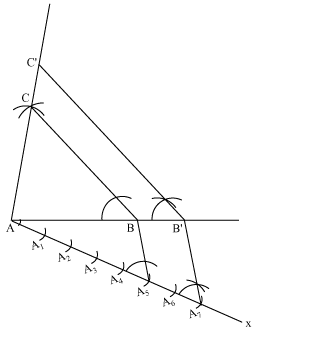
Question 4. Construct an isosceles triangle whose base is 8 cm and altitude 4 cm and then another triangle whose sides are 1.5 times the corresponding sides of the isosceles triangle.
Solution:
Let ∆ABC be an isosceles triangle having CA and CB of equal lengths, base AB is 8 cm and AD is the attitude of length 4 cm.
Now, the steps of construction are as follows:
1. Draw a line segment AB of 8 cm. Draw arcs of same radius on both sides of line segment while taking point A and B as its centre. Let these arcs intersect each other at 0 and O’. Join 00′. Let 00’ intersect AB at D.
2. Take D as centre and draw an arc of 4 cm radius which cuts the extended line segment 00’ at point C. Now an isosceles ∆ABC is formed, having CD (attitude) as 4 cm and AB (base) as 8 cm.
3. Draw a ray AX making an acute angle with line segment AB on opposite side of vertex C.
4. Locate 3 points (as 3 is greater between 3 and 2) on AX such that AA1 = A1A2 = A2A3.
5. Join BA2 and draw a line through A3 parallel to BA2 to intersect extended line segment AB at point B’.
6. Draw a line through B’ parallel to BC intersecting the extended line segment AC at C’ ∆AB’C’ is the required triangle.
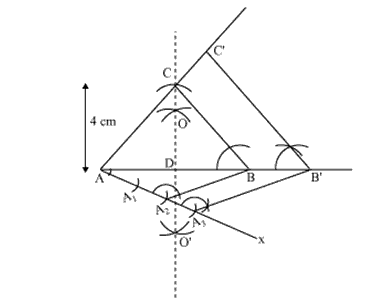
Question 5. Draw a triangle ABC with side BC = 6 cm, AB = 5 cm and ∠ABC = 60°. Then construct a triangle whose sides are 3/4 of the corresponding sides of the triangle ABC.
Solution:
The steps of construction are as follows:
1. Draw a line segment BC of length 6 cm. Draw an arc of any radius while taking B as centre. Let it intersect line BC at point O. Now taking O as centre draw another arc to cut the previous arc at point O’. Joint BO’ which is the ray making 600 with line BC.
2. Now draw an arc of 5 cm. radius, while taking, B as centre, intersecting extended line segment BO’ at point A. Join AC. ∆ABC is having AB = 5 cm. BC = 6 cm and ∠ABC = 600.
3. Draw a ray BX making an acute angle with BC on opposite side of vertex A.
4. Locate 4 points (as 4 is greater in 3 and 4). B1, B2, B3, B4 on line segment BX.
5. Join B4C and draw a line through B3, parallel to B4C intersecting BC at C’.
6. Draw a line through C’ parallel to AC intersecting AB at A’. ∆A’BC’ is the required triangle.

Question 6. Draw a triangle ABC with side BC = 7 cm, ∠B = 45°, ∠A = 105°. Then, construct a triangle whose sides are 4/3 times the corresponding sides of Δ ABC.
Solution:
∠B = 45°, ∠A = 105°
It is known that the sum of all interior angles in a triangle is 180°.
∠B + ∠C = 180°.
105° + 45° + ∠C = 180°
∠C = 180° — 150° = 30°
Now, the steps of construction are as follows:
1. Draw a line segment BC = 7 cm. Draw an arc of any radius while taking B as centre. Let it intersects BC at P. Draw an arc from P, of same radius as before, to intersect this arc at Q. From Q, again draw an arc, of same radius as before, to cut the arc at R. Now from points Q and R draw arcs of same radius as before, to intersect each other at S. Join BS.
Let BS intersect the arc at T. from T and P draw arcs of same radius as before to intersect each other at U. Join BU which is making 45° with BC.
2. Draw an arc of any radius taking C as its centre. Let ¡t intersects BC at O. Taking O as centre, draw an arc of same radius intersecting the previous arc at O’. Now taking O and O’ as centre, draw arcs of same radius as before, to intersect each other at Y. Join CY which is making 30° to BC.
3. Extend line segment CY and BU. Let they intersect each other at A.
∆ABC is the triangle having ∠A = 105°, ∠B = 45° and BC = 7 cm.
4. Draw a ray BX making an acute angle with BC on opposite side of vertex A.
5. Locate 4 points (as 4 is greater in 4 and 3) B1, B2, B3, B4 on BX.
6. Join B3C. Draw a line through B4 parallel to B3C intersecting extended BC at C’.
7. Through C’ draw a line parallel to AC intersecting extended line segment at C’. ∆’BC’ is required triangle.
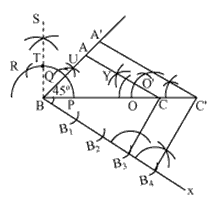
Question 7. Draw a right triangle in which the sides (other than hypotenuse) are of lengths 4 cm and 3 cm. Then construct another triangle whose sides are 5/3 times the corresponding sides of the given triangle.
Solution:
The steps of construction are as follows:
1. Draw a line segment AB = 4 cm draw a ray SA making 90° with it.
2. Draw an arc of 3 cm radius while taking A as its centre to intersect SA at C. Join BC. ∆ABC is required triangle.
3. Draw a ray AX making an acute angle with AB, opposite to vertex C.
4. Locate 5 points (as 5 is greater in 5 and 3) A1, A2, A3, A4, A5 on line segment AX.
5. Join A3B, Draw a line through A5 parallel to A3B intersecting extended line segment AB at B’.
6. Through B’ draw a line parallel to BC intersecting extended line segment AC at C’. ∆ABC’ is required triangle.

We hope the NCERT Solutions for Class 10 Maths Chapter 11 Constructions Ex 11.1 help you. If you have any query regarding NCERT Solutions for Class 10 Maths Chapter 11 Constructions Ex 11.1, drop a comment below and we will get back to you at the earliest.
NCERT Solutions For Class 10 Maths – AplusTopperhttps://t.co/q7hSKh3xmf#NCERTSolutionsForClass10Maths #NCERTSolutions #AplusTopper
— ObulReddy cbse (@ObulReddyCBSE) August 3, 2018
